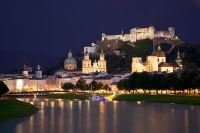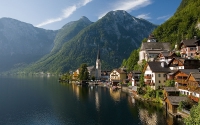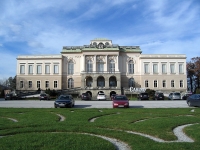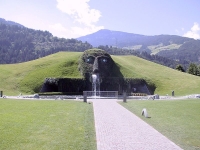Salzburg Travel Guide
Salzburg is perhaps the quintessential Austria, where grand buildings, steep hills and crisp mountain air come together in glorious fashion. Famously the birthplace of Mozart, the sublime composer's influence is difficult to ignore, as his image is on every postcard and chocolate box, and both his birthplace and family home are now museums offering detailed insight into his life and work. The city celebrates its most notable son during the Salzburg Festival, which presents world-class concerts and performances of opera and drama each summer.
Salzburg is also the hometown of Baroque, and the south side of the river is a beautiful Baroque sprawl of charming churches, squares, houses and fountains. The original buildings were cleared in the late 1500s by Prince Archbishop Wolf Dietrich von Raitenau in order to create a 'German Rome'.
All the main sights are within walking distance of the spacious old city (Altstadt), which is now largely pedestrianised. A few miles to the south of the city are the historic towns of Hallein and Werfen, and to the west are the lakes of Salzberger, which are especially worth visiting during the spring and summer when the wildflowers are out.
Things to do in Salzburg
Though Salzburg is the hometown of Mozart and a classical music lover's delight, it is also a haven for romantics, who will revel in the beauty of its scenery, architecture and lyrical setting. Opulent Baroque castles, concert halls and churches abound and are a feast for the eye and the soul, as are the surrounding hills and mountains.
The most popular and worthwhile tourist attractions in Salzburg include the mighty Hohensalzburg Fortress, the two Mozart museums situated in his birthplace and former residence, the Museum of Modern Art, the Salzburg Museum, the Museum of Natural History, the Salzburg Zoo and the Hellbrunn Palace.
Those planning on doing a lot of sightseeing should look into buying the Salzburg Card, which provides free entry or discounts on attractions, public transport and even concerts and theatre performances. The card can be purchased at info booths in the city and at many hotels.
The central core of Salzburg is easy and pleasant to explore on foot. There are buses and streetcars available, for which a 24-hour pass can be bought that includes the use of the Hohensalzburg Funicular. Taxis are plentiful at visible ranks throughout the city, but they are expensive.

Hohensalzburg Fortress
The 11th-century Hohensalzburg Castle stands on a rocky outcrop approximately 394ft (120m) above the city. Originally built by Archbishop Gebhard to repel attacks from the neighbouring Bavarians, the present-day fortress was largely rebuilt in the early 16th century with added grand state apartments. Visitors can walk around the courtyard and outskirts of the fortress at no cost unless they take the guided tour. The tour finishes at two small museums displaying a selection of weapons, uniforms and armour, together with villainous instruments of torture. The castle can be reached by funicular or by a walking path.
St Peter's Abbey
Founded in the seventh century by Rupert, patron saint of Salzburg, Austria, and salt miners, St Peter's is the oldest monastery in the German-speaking world and the spiritual heart of the city of Salzburg. It is historically known the world over for monk-led writing classes that produced students with exceptional skill in literature, printing and penmanship, and still houses the oldest library in Austria. Visitors can look forward to its simple Baroque-style exterior, and an interior made up of swirling oceanic shapes on the ceiling, golden vines along the walls, and frescos of various biblical scenes along the nave.
Mozart's Birthplace
Perhaps the most gifted composer in the history of classical music, Wolfgang Amadeus Mozart was born in 1756 at his family's home in Getreidegasse. The house has since been converted into a museum displaying exhibits that include the violin played by Mozart as a child, his concert violin and clavichord, a pianoforte and various portraits. The museum was first opened in 1880 by the International Mozart Foundation and is now said to be one of the most frequently visited museums in the world. Tours of the museum are available but need to be arranged in advance. A basic tour of the exhibition takes about an hour. The museum provides a fascinating introduction to the Mozart family, as well as detailing their early life.

Salzkammergut Lakes
The Salzkammergut is a lake area is an alpine wonderland of towering peaks, pristine lakes and deeply carved valleys. Spanning Upper Austria, Salzburg and Styria, it was formerly home to the salt mines of the Habsburg Empire. The many lakes and mountains in the region lend themselves to a variety of activities such as water sports, golf, cycling and hiking, as well as relaxing at the beautiful shore and hillside retreats. Visitors should take some time out to enjoy the local kaiserschmarrn (sugared pancakes with raisins), lebkuchen (gingerbread) and krapfen (doughnuts), and the spectacular scenery in one of Austria's most lovely regions. Parts of the region have been declared a UNESCO World Heritage Site, including the towns of Hallstatt, Obertraun, Gosau and Bad Goisern.

Schloss Klessheim Palace
Dating as far back as the 17th century, Schloss Klessheim Palace was used by Adolf Hitler during World War II and today serves as a casino with an elegant atmosphere and beautiful gardens. The palace also featured in the 1965 film The Great Race starring Jack Lemmon, Tony Curtis and Peter Falk. The casino holds some historical interest because of the association with Hitler during the war, and the eagles displayed at the palace entrance are reminiscent of the Third Reich. However, the main appeal is the chance to gamble and party the night away in style!

Swarovski Crystal World
Guarded by a water-spouting giant, Swarovski Crystal World is one of the most popular attractions in Tirol. The museum is underground, featuring 14 interconnected rooms with an eclectic multimedia gallery showcasing dazzling work by Picasso, Andy Warhol, Dali and Marc Chagall, all featuring the distinctive glint of the famous Austrian crystals. Another popular sight is the largest crystal in the world, located in the first room. Just a 15-minute drive from Innsbruck and less than two hours drive from Salzburg, Swarovski is a popular excursion from both cities. The Swarovski Crystal World gift shop has an equally sparkling array of souvenirs available at lower prices than in town, with the opportunity for a tax rebate for foreign visitors.
Salzburg Climate and Weather
Salzburg has a continental climate with Alpine influences because of its proximity to the mountains. Summers are warm and pleasant, although rainy days are common. Winters are cold, with temperatures hovering just above or below freezing, with plentiful snow.
Salzburg experiences a long, beautiful summer lasting from Easter through to mid-October. But the most popular months for a holiday in Salzburg are July and August, when the main festivals take place and tourists crowd the streets. Winter brings winter sports enthusiasts into the city on their way to or from the ski slopes.
Austria travel info
Electricity
Electrical current is 230 volts, 50Hz. European two-pin plugs are standard.
Language
The official language in Austria is German.
Money
The unit of currency is the euro (EUR). Currency can be exchanged at banks and bureaux de change available in all towns, but it may be easier to use the ATMs. Banks are closed on Saturdays and Sundays, but bureaux de change at airports and major city rail terminals are open seven days a week. Most credit and debit cards are widely accepted though some small hotels and restaurants may only accept cash.
Tipping
A 10 to 15 percent service charge is normally added to hotel and restaurant bills in Austria, but it is customary to leave another five percent if satisfied with the service. Sometimes, patrons can round off the bill. Bartenders usually expect a rounded-up tip. It is common to give the money to the waiter rather than leave it on the table, but leaving small change for other service personnel is fine. Taxi drivers expect a 10 percent tip.
Health
All eligible travellers should be up to date with their COVID-19 vaccines. Water and food are safe and medical facilities are excellent; citizens of EU countries can get free emergency medical treatment at public hospitals in Austria on production of a European Health Insurance Card (EHIC). After Brexit, the Global Health Insurance Card (GHIC) replaced the European Health Insurance Card (EHIC) for UK citizens. The GHIC allows UK citizens access to state healthcare during visits to the EU. The GHIC is not valid in Norway, Iceland, Liechtenstein or Switzerland, nor is it an alternative to travel insurance.
Safety
Travel to Austria is generally trouble-free. However, visitors are advised to take sensible safety precautions to avoid petty theft, particularly in larger cities.
Local customs
The most common and courteous greeting is the handshake, which is normal regardless of age and gender. Many Austrians value their physical and personal privacy when among strangers, so it's best to respect their personal space. A good conversation topic is the country's regional diversity, as Austrians enjoy talking about their home region. It is compulsory that vehicles are driven with their lights on throughout the year; smoking is not allowed in many public places.
Doing business
Business protocol is very important in Austria and business is formal, structured and conservative, more so than in many other Western European countries. All correspondence should be formal. Dress is conservative yet elegant; Austrians take great pride in their appearance and a good quality, well-fitting suit for men and women should be worn to make a good first impression. Austrians are also very title-conscious, and it's best to always use last names with a preceding title such as Herr (Mr), Frau (Mrs) or Fraulein (Miss), along with their professional or academic title where applicable (e.g. Herr Professor Kaufmann). It is vital to arrive punctually for meetings and to be thoroughly prepared, as meetings are brief and to the point. Foreigners should be prepared to engage in preliminary small talk, including a knowledge of current affairs, before getting down to business. English is widely spoken in business, but printed literature should be in German if possible. Offices open at 8am and close promptly at 5pm, Monday to Friday.
Duty free
Travellers from non-EU countries over 17 years are allowed to bring in the following items without paying customs duty: 200 cigarettes, or 100 cigarillos, or 50 cigars, or 250g of smoking tobacco, or a proportional mix of these products; 4 litres non-sparkling wine, or one litre of spirits with alcohol content more than 22 percent, or two litres of alcohol volume less than 22 percent; 60ml perfume and 250ml eau de toilette; and other goods to a total value of €430. Restricted items include pornographic material and fresh foodstuffs such as meat and dairy products. Travellers must have a European Firearms Pass if travelling with firearms.
Communications
The international access code for Austria is +43. Hotels, cafes and restaurants offering free WiFi are widely available. As international roaming costs can be high, purchasing a local prepaid SIM card can be a cheaper option.
Passport & Visa
The borderless region known as the Schengen area includes the following countries: Austria, Belgium, Czech Republic, Denmark, Estonia, Finland, France, Germany, Greece, Hungary, Iceland, Italy, Latvia, Lithuania, Luxembourg, Malta, The Netherlands, Norway, Poland, Portugal, Slovakia, Slovenia, Spain, and Sweden. All these countries issue a standard Schengen visa that has a multiple entry option that allows the holder to travel freely within the borders of all. For most nationalities, passports are required to be valid for three months beyond period of travel. It's recommend that passports be valid for six months from the departure date.
Entry requirements
US passport holders require a passport valid for three months beyond period of intended stay, but a visa is not needed for a stay of up to 90 days.
British passports require at least three months validity beyond the period of intended stay in Austria. No visa is required for stays of up to 90 days.
Canadians require a passport valid for three months beyond intended period of stay, but no visa is needed for a stay of up to 90 days.
Australians require a passport valid for three months beyond period of intended stay, but no visa is needed for a stay of up to 90 days.
South African nationals require a passport valid for three months beyond the period of intended stay and a visa. Visitors can enter with a 'C' or 'D' visa issued by a Schengen Member State for a maximum of 90 days in a period of 180 days.
Irish nationals require a passport but no visa is needed for travel to Austria.
New Zealanders require a passport valid for three months beyond period of intended stay, but a visa is not needed for a stay of up to 90 days.
Useful contacts
Austrian National Tourist Office, Vienna: +43 (0)1 588 660 or www.austria.info
133 (police), 140 (mountain rescue), 144 (ambulance)


